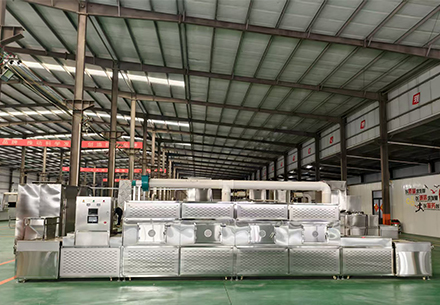


The efficient and stable operation of microwave equipment depends on scientific and standardized daily maintenance, which needs to be implemented from multiple dimensions such as cavity cleaning, core system maintenance, mechanical transmission inspection, electrical safety and environmental management.
Cleaning of cavity and contact area
Daily cleaning: Use a soft cloth or brush to remove residual materials from the inner wall of the cavity and the conveyor belt (turntable) to prevent debris accumulation that affects microwave reflection efficiency or causes local overheating. Do not use strong corrosive detergents, use neutral detergents to clean and wipe dry to prevent corrosion of the coating or sparks caused by conductive residues.
In-depth maintenance: Check the cavity sealing strips every week and remove debris from the grooves. If the strips are aged or deformed, they need to be replaced in time to avoid microwave leakage. Turntable equipment needs to be disassembled regularly for soaking and cleaning to ensure smooth rotation.
Microwave generation system maintenance
Magnetron and waveguide maintenance: For air-cooled equipment, check the operation of the cooling fan and dust accumulation at the air inlet daily to ensure heat dissipation; for water-cooled equipment, use deionized water/softened water, regularly check the water flow pressure and pipe scaling, and clean or replace the pipes in time. Clean the waveguide port stains weekly to ensure loss-free transmission of microwaves.
Control system and sensor calibration
Parameter verification: Check the consistency of power, temperature, time and other parameters with the set values, and test the sensitivity of sensors such as infrared temperature measurement and thermocouples. Use a standard thermometer to calibrate the cavity temperature every month to ensure the accuracy of parameters (such as 121℃/15 minutes).
Circuit inspection: Check the control box circuit for looseness, insulation damage and terminal oxidation every week, clean the contactor and relay dust, and ensure stable signal transmission.
Maintenance of mechanical transmission parts
Conveyor belt/turntable system: Observe the smoothness of the conveyor belt every day to avoid deviation and wear. The chain drive needs to be regularly filled with food-grade lubricant; check the bearing lubrication and rotation balance of the turntable equipment to prevent tilting or abnormal noise.
Door structure: Push and pull the door gently when opening and closing, tighten the door shaft screws every week, and check whether the door is closed evenly to ensure the reliability of the seal.
Power supply and grounding safety
Power supply guarantee: Connect to an independent voltage-stabilized power supply to avoid voltage fluctuations caused by sharing the same line with high-power equipment; check whether the power plug/socket is in good contact every day, and clean the oxide in time.
Grounding protection: Check the firmness of the grounding wire every month (grounding resistance ≤ 4Ω), and it is recommended to cut off the power in thunderstorm weather to prevent leakage and electromagnetic interference from affecting the control accuracy.
Environmental management and recording
Operating environment: Keep the equipment dry and ventilated, away from steam, water and strong magnetic fields, clean the dust on the top/bottom regularly, and blow the control box with dry air every week in a high humidity environment to prevent the circuit board from getting wet.
Maintenance log: Establish an "Equipment Maintenance Log" to record daily cleaning, component replacement (such as rubber strips, fans), fault handling and other information, so as to facilitate tracing maintenance cycles and predicting equipment status.
Abnormal emergency and long-term maintenance
If there is any abnormal noise, spark, odor or sudden temperature rise during operation, immediately shut down the machine and contact professional maintenance. It is strictly forbidden to disassemble high-voltage components by yourself. When the equipment is not used for a long time, it should be powered on for 10 minutes every month to prevent moisture and store in a dry and dust-proof environment.
The above maintenance measures divided into periods and modules can effectively extend the life of the equipment and reduce safety risks.